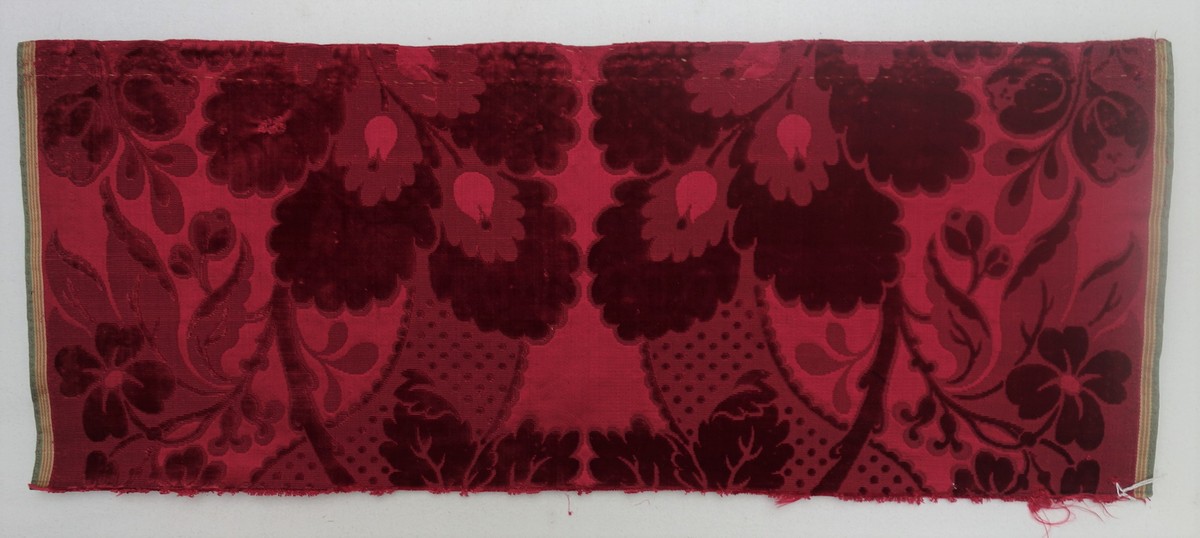The creation of a series of loops (a pile) while making a textile is not a new idea. The ancient Egyptians created piled linen textiles as early as the Middle Kingdom (c. 2000 BC). There were piled carpets at the archaeological site of Pazyryk in what is now Siberia, and these date to the 4th century BC. Their characteristic feature lies in the use of relatively short lengths of loops or tufts in the weft direction, and not in the warp threads as with ‘proper’ velvets.
It has also been suggested that velvet is Chinese in origin and came to Europe via the Silk Roads, or that it came westwards via the Mongols and the invasion of southwestern Asia in the 13th century. But there is no direct evidence for either of these suggestions.
What is more certain is that there are references to kutuf, which may have been the Arabic term for velvet, in early Arabic literature, notably to its production and use at the court of the Umayyad Caliph, Hisham ibn Abd al-Malik (691-743) in Damascus, Syria. It would appear that he and his court used both silks and velvets: "Hisham used to be fond of robes and carpets …. In his days there were made, striped silk (al-khazz rakm) and velvets (kutuf)." (Serjeant 1973:14)
There are also references in the 10th century AD Persian geography, the Hudud al-`Alam, to katifa (kutuf) cloth being made in the north of what is now the Islamic Republic of Iran.
One of the earliest written European references to velvet dates from 1311 AD and refers to items owned by Pope Clement V (reign: 1305-1314), including two lengths of red velvet from the north Italian city of Lucca. Since the early 12th century, this town, near Pisa, had been a major producer of silk textiles of various kinds.

By the mid-14th century Lucca suffered various economic problems, which were exacerbated by the advent in 1348 of the Black Death in the city that killed many of its residents. Numerous craftsmen from Lucca, including silk merchants and velvet weavers, left the city and set up new businesses in cities such as Venice, Florence, Genoa and Milan. Not surprisingly, by the end of the 14th century these cities had a flourishing silk weaving production that included the production of velvet. At the same time, the French king Louis XI (reign: 1461-1483) deliberately enticed Italian silk weavers to come to France and helped them set up velvet weaving centres in Lyons and Tours. The weavers were given tax exemptions (sometimes for life) in order to build up the French industry.
At the same time the Spanish court encouraged Italian weavers to come to the Iberian Peninsula and to settle in cities such as of Barcelona, Toledo and Valencia. Although all of this helped to increase the production of French and Spanish velvet, it never grew to the same status as the Italian velvet trade. Velvets from Italy were also traded with northern Europe, including The Netherlands, and velvets for the English court sere shipped via Antwerp.
During the 14th-16th centuries various Italian cities were importing silk from what is now Iran and Syria and exporting silk textiles, including velvets, back to these countries. In addition, during the reigns of the Ottoman sultans, such as Suleiman I (reign: 1520-1566), for example, many velvets were made within the Ottoman empire. Yet Italian silk velvets were an important textile in court life and there are still Italian silk velvet garments in the Topkapi Palace Museum in Istanbul. But it was not only the Ottoman rulers who appreciated velvet. At the same time the Persian silk velvets were being produced in Isfahan, the capital of the Persian Safavid Empire. These velvets often depicted men and women in idyllic scenes representing Paradise.


It is also likely that woollen versions were being produced in Utrecht (The Netherlands), but this is not certain. The term velours d’Utrecht (compare TRC 2018.2502; TRC 2018.2503, and TRC 2018.2514) may have come from woollen velvets woven in north-eastern France, notably in Rouen, where these textiles were woven on drawlooms. The Dutch word to pull is ‘trek’ and it has been suggested that velvet woven on a drawloom may actually have been a velours de trek, from which the word velours d’Utrecht was derived.

